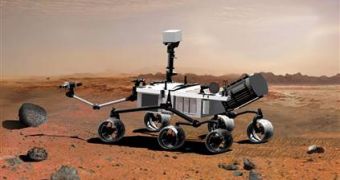Forget about sending a nuclear powered rover to the surface of the Red Planet, NASA officials say! The mission may stop right before it even stars due to related costs rising at an alarming rate. The mission is dead in the water since previous tests have shown that the current design of the vehicle, which is supposed to deliver it to the surface of the planet, does not have a protective shield good enough to survive the entry into Mars' thin atmosphere.
According to NASA administrator Michael Griffin, the funds required to make the correct adjustments to the thermal shield of the spacecraft would range between 20 to 30 million dollars, meaning that the total cost of the mission would rise to an astounding 1.8 billion dollars, which is already over the original allocated budget by 165 million dollars.
The mission to the Red Planet is supposed to launch in the end of next year, and, by the looks of the current situation, there is no way it will ever leave this planet, considering the fact that NASA also has in plan to send missions to Mars in 2010 and 2011. The situation is even more desperate, as the US space agency already canceled a mission in order to give priority to the Mars Science Lab, due to a conflict of interests in the purchasing process.
If indeed it will launch by the end of 2009, the Mars Science Lab will become the most advanced mission sent to the surface of Mars, being equipped with a rover which will be capable to drive way further than the age old Spirit and Opportunity combined, in the four years of mission. Although still functional, it is quite clear that the two rovers will not survive for much longer in the rough conditions of Mars. During the four years of mission, the twin rovers gathered invaluable information regarding geologic surveys, while the Mars Science Lab targets the study of the past Martian environment, in hope to determine whether the conditions have been favorable for the appearance and evolution of life.
Alternatively, NASA is seriously pondering over the possibility of sending a manned mission to the Red Planet soon after the scheduled mission to the Moon.
Griffin says that, originally, the thermal shield of the Mars Science Lab was rather similar to that of the external fuel tank of NASA's space shuttles, albeit, as we saw in the Columbia disaster, the protective foam covering the structure is extremely fragile, thus it may fail during entry. So they turned to the possibility of using a thermal shield similar to that used on the Stardust probe; considering the fact that Stardust experienced twice the stress of that during a Mars atmosphere entry, the shield should not have had any problems. However, things proved to be more complicated than that.
It wouldn't be the first time when such things happen with the Mars Science Lab. For example, during last year, NASA decided to renounce to one of the cameras equipping the spacecraft while the work on a laser instrument was totally stopped. Any further delays will ultimately translate into even more costs, a situation NASA cannot accept, but, if such a thing may happen, they could stop the mission altogether and raise some serious questions related to the effectiveness of sending robotic missions to other planets.

 14 DAY TRIAL //
14 DAY TRIAL //